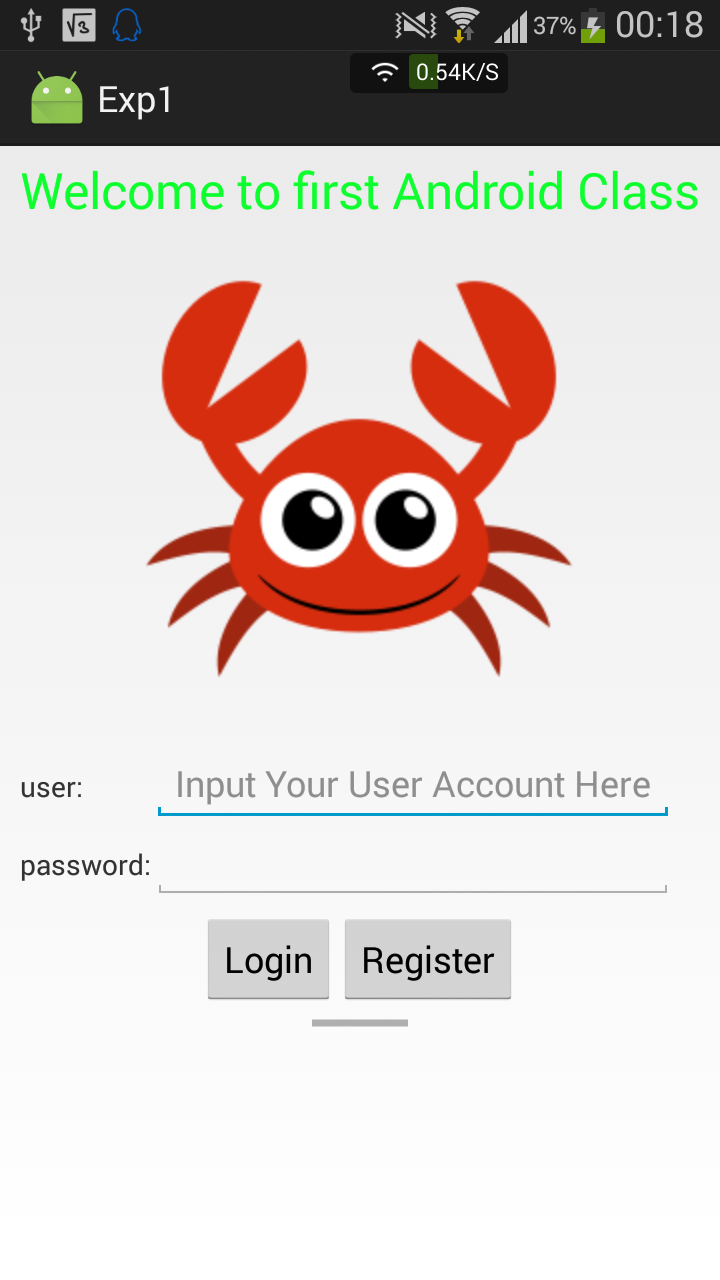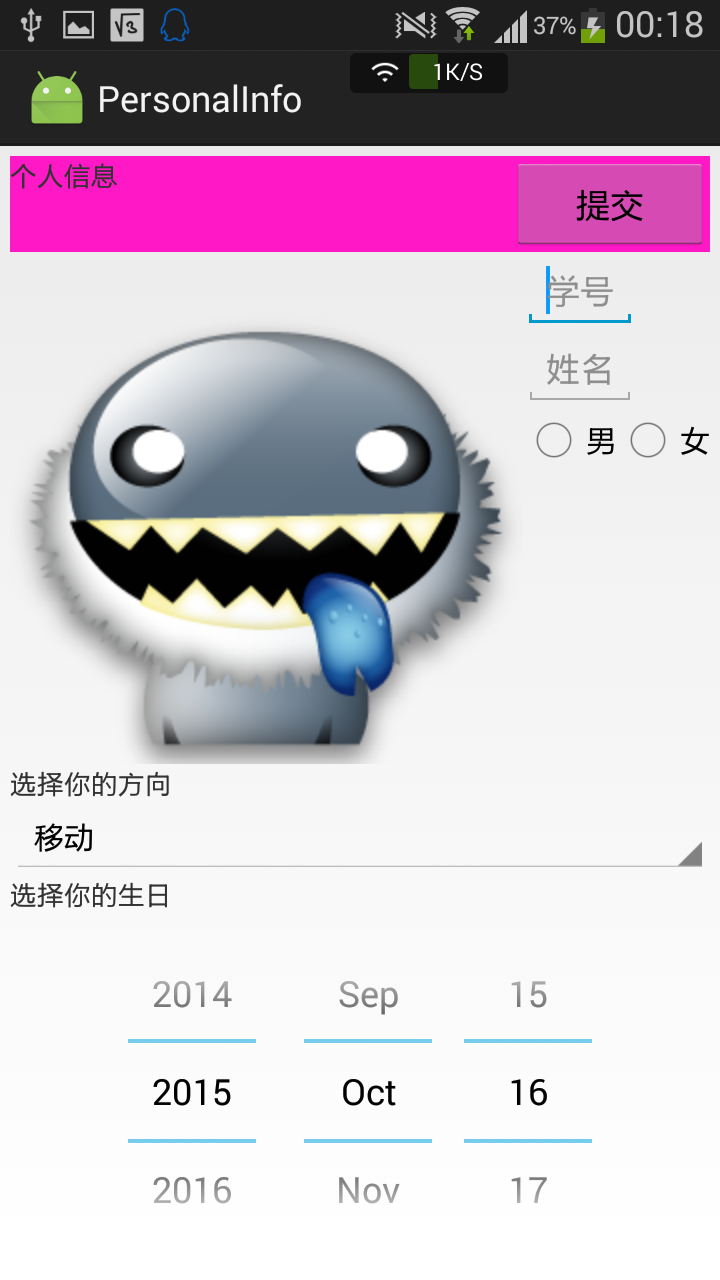Android实现入门界面布局
Android实现入门界面布局
开发工具:Andorid Studio 1.3
运行环境:Android 4.4 KitKat
代码实现
首先是常量的定义,安卓中固定字符串应该定义在常量中。
strings.xml
<resources><string name="app_name">Exp1</string><string name="title_activity_personal_info">PersonalInfo</string><string name="welcome_info">Welcome to first Android Class</string><string name="personal_info">个人信息</string><string name="submit">提交</string><string name="student_id">学号</string><string name="name">姓名</string><string name="man">男</string><string name="woman">女</string><string name="register">Register</string><string name="login">Login</string><string name="user">user:</string><string name="input_hint">Input Your User Account Here</string><string name="input_password">password:</string><string name="pick_aspect">选择你的方向</string><string name="pick_birthday">选择你的生日</string></resources>
color.xml
<?xml version="1.0" encoding="utf-8"?><resources><color name="green">#0eff2e</color><color name="purple">#ff18c5</color></resources>
arrays.xml
<?xml version="1.0" encoding="utf-8"?><resources><string-array name="aspect"><item>移动</item><item>软院</item><item>管理</item><item>政务</item><item>环境</item></string-array></resources>
界面一:(LinearLayout、TableLayout)
<LinearLayout xmlns:android="http://schemas.android.com/apk/res/android"xmlns:tools="http://schemas.android.com/tools"android:layout_width="match_parent"android:layout_height="match_parent"android:paddingLeft="5dp"android:paddingRight="5dp"android:paddingTop="5dp"android:paddingBottom="5dp"android:orientation="vertical"tools:context=".MainActivity"><TextViewandroid:layout_width="match_parent"android:layout_height="wrap_content"android:textAppearance="?android:attr/textAppearanceSmall"android:text="@string/welcome_info"android:id="@+id/title"android:textColor="@color/green"android:textSize="25sp"android:gravity="center"/><ImageViewandroid:layout_width="match_parent"android:layout_height="wrap_content"android:id="@+id/logoImage"android:src="@mipmap/crab"/><TableLayoutandroid:layout_width="match_parent"android:layout_height="wrap_content"android:paddingLeft="5dp"android:paddingRight="5dp"android:paddingTop="5dp"android:paddingBottom="5dp"><TableRow><TextViewandroid:layout_width="wrap_content"android:layout_height="wrap_content"android:text="@string/user"/><EditTextandroid:layout_height="wrap_content"android:layout_width="fill_parent"android:hint="@string/input_hint"/></TableRow><TableRow><TextViewandroid:layout_width="wrap_content"android:layout_height="wrap_content"android:text="@string/input_password"/><EditTextandroid:layout_width="fill_parent"android:layout_height="wrap_content"/></TableRow></TableLayout><LinearLayoutandroid:orientation="horizontal"android:layout_width="match_parent"android:layout_height="wrap_content"android:gravity="center"><Buttonandroid:layout_width="wrap_content"android:layout_height="wrap_content"android:text="@string/login"android:id="@+id/btn_login" /><Buttonandroid:layout_width="wrap_content"android:layout_height="wrap_content"android:text="@string/register"android:id="@+id/btn_register" /></LinearLayout><ProgressBarstyle="?android:attr/progressBarStyleHorizontal"android:layout_width="wrap_content"android:layout_height="wrap_content"android:id="@+id/progressBar"android:layout_gravity="center_horizontal" /></LinearLayout>
注意:
- 外层的定义可以使用LinearLayout,加上属性android:orientation="vertical",就变成了线性垂直布局,这是安卓开发中比较常用的基本布局。
- TableLayout中实现占据一行剩余空间还有另一种实现方法,
<EditText android:layout_width="0dp" android:layout_weight="1" />,重点就在于layout_weight这上面。 - 两个button水平居中的实现使用的是嵌套布局,也就是在Layout中还有Layout,但要合理使用Layout,避免区域重复渲染,安卓开发者人员调试工具中可以看到渲染情况。
界面二:
<LinearLayout xmlns:android="http://schemas.android.com/apk/res/android"xmlns:tools="http://schemas.android.com/tools"android:layout_width="match_parent"android:layout_height="match_parent"android:paddingLeft="5dp"android:paddingRight="5dp"android:paddingTop="5dp"android:paddingBottom="5dp"android:orientation="vertical"><FrameLayoutandroid:layout_width="match_parent"android:layout_height="wrap_content"android:background="@color/purple"><TextViewandroid:layout_width="wrap_content"android:layout_height="wrap_content"android:text="@string/personal_info"/><Buttonandroid:layout_width="wrap_content"android:layout_height="wrap_content"android:layout_gravity="end"android:text="@string/submit"android:minWidth="100dp"android:id="@+id/submit"/></FrameLayout><LinearLayoutandroid:orientation="horizontal"android:layout_width="match_parent"android:layout_height="wrap_content"><ImageViewandroid:layout_width="wrap_content"android:layout_height="wrap_content"android:src="@mipmap/avatar"android:id="@+id/avatar" /><LinearLayoutandroid:layout_width="wrap_content"android:layout_height="wrap_content"android:orientation="vertical"><EditTextandroid:layout_width="wrap_content"android:layout_height="wrap_content"android:hint="@string/student_id"/><EditTextandroid:layout_width="wrap_content"android:layout_height="wrap_content"android:hint="@string/name"/><RadioGroupandroid:layout_width="wrap_content"android:layout_height="wrap_content"android:orientation="horizontal"><RadioButtonandroid:layout_width="wrap_content"android:layout_height="wrap_content"android:text="@string/man"/><RadioButtonandroid:layout_width="wrap_content"android:layout_height="wrap_content"android:text="@string/woman"/></RadioGroup></LinearLayout></LinearLayout><TextViewandroid:layout_width="fill_parent"android:layout_height="wrap_content"android:text="@string/pick_aspect"/><Spinnerandroid:layout_width="fill_parent"android:layout_height="wrap_content"android:id="@+id/aspect"android:entries="@array/aspect"android:prompt="@string/pick_aspect"></Spinner><TextViewandroid:layout_width="fill_parent"android:layout_height="wrap_content"android:text="@string/pick_birthday"/><DatePickerandroid:layout_width="fill_parent"android:layout_height="wrap_content"android:calendarViewShown="false"></DatePicker></LinearLayout>
注意:
- FrameLayout会将所有的子元素放在整个布局的左上角,后面的子元素会直接覆盖前面的子元素,因此需要添加layout_gravity参数控制方向。
效果图
由于是真机测试,因此给两个按钮加入了跳转响应,这些内容在后面的博客中再讲实现。


一些总结
学到的东西:
- android:orientation="vertical"
布局的方向 - android:layout_width="match_parent"
和父级元素同样的宽度 - android:layout_width="fill_parent"
填充父级元素剩余的宽度 - android:layout_height="wrap_content"
根据内容来决定高度 - android:gravity="center"
决定自动靠拢的位置 - android:textColor="@color/green"
修改文本中文字的颜色 - android:src="@mipmap/crab"
图片的源地址 - android:layout_gravity="center_horizontal"
水平居中 - android:minWidth="100dp"
最小的宽度设置 - android:background="@color/purple"
布局控件的底色 - android:entries="@array/aspect"
Spinner控件的静态内容 - android:calendarViewShown="false"
DataPicker隐藏日历的方法
不同的Layout的简要不同:
| Layout名称 | 区别 |
|---|---|
| LinearLayout | 按照水平或垂直的顺序将子元素(可以是控件或布局)依次按照顺序排列,每一个元素都位于前面一个元素之后 |
| TableLayout | 适用于多行多列的布局格式,每个TableLayout是由多个TableRow组成,一个TableRow就表示TableLayout中的每一行,这一行可以由多个子元素组成 |
| RelativeLayout | 按照子元素之间的位置关系完成布局 |
| FrameLayout | 将所有的子元素放在整个界面的左上角,后面的子元素直接覆盖前面的子元素 |
| AbsoluteLayou | 将所有的子元素通过设置android:layout_x 和 android:layout_y属性,将子元素的坐标位置固定下来 |
| GridLayout | 使用虚细线将布局划分为行、列和单元格,也支持一个控件在行、列上都有交错排列 |
工程下载
传送门:下载
Android实现入门界面布局的更多相关文章
- Android 你知道界面布局嵌套多少层之后会Crash吗
我们先放一张Hierarchy Viewer的图:(模拟器Android4.4) 看到数字6了吗,那个RelativeLayout是MainActivity的根ViewGroup, 而在Relativ ...
- android 入门 001 (界面布局)
学android 首先学会怎么布局界面,我开始是学.net的,因工作需要学习一下安卓,外行写的不好,请多多见谅指教 .这一篇文章然我们来学习一下四种布局吧! RelativeLayout(相对布局) ...
- Android新手入门2016(7)--布局
布局,这个在服务端变成是没有的,也是服务端的人学习client的一道坎吧. 曾经用cocos2d-x写小游戏的时候就是这个非常难懂,或者能用,可是理解不多的话,非常难写出好的布局,难以适合商业化的应用 ...
- 2013 duilib入门简明教程 -- 界面布局(9)
上一个教程实现的标题栏代码中,并没有看到处理自适应窗口大小的代码,但是窗口大小变化后,按钮的位置会跟着变化,这是因为我们将按钮放到了HorizontalLayout.VerticalLayou ...
- Android界面布局基本知识简述
Android手机操作系统在模拟器中进行相关的编写,可以帮助我们实现各种功能需求.尤其是在界面的操作方面显得更为突出.在这里我们就可以对Android界面布局的相关操作来对这方面的知识进行一个深入的了 ...
- Android基础总结(3)——UI界面布局
Android的UI设计有好几种界面程序编写方式.大体上可分为两大类:一类是利用可视化工具来进行,允许你进行拖拽控件来进行布局:还有一类是编写xml文档来进行布局.这两种方法可以相互转换. 1.常见的 ...
- [Android 性能优化系列]降低你的界面布局层次结构的一部分
大家假设喜欢我的博客,请关注一下我的微博,请点击这里(http://weibo.com/kifile),谢谢 转载请标明出处(http://blog.csdn.net/kifile),再次感谢 原文地 ...
- duilib入门简明教程 -- 界面布局(9)
上一个教程实现的标题栏代码中,并没有看到处理自适应窗口大小的代码,但是窗口大小变化后,按钮的位置会跟着变化,这是因为我们将按钮放到了HorizontalLayout.VerticalLayou ...
- duilib入门简明教程 -- 界面布局(9) (转)
原文转自:http://www.cnblogs.com/Alberl/p/3343806.html 上一个教程实现的标题栏代码中,并没有看到处理自适应窗口大小的代码,但是窗口大小变化后,按钮的 ...
随机推荐
- How to search compound files
Last week my friend told me that she made a terrible mistake. She conducted raw serch and found no s ...
- Reactor模式解析——muduo网络库
最近一段时间阅读了muduo源码,读完的感受有一个感受就是有点乱.当然不是说代码乱,是我可能还没有完全消化和理解.为了更好的学习这个库,还是要来写一些东西促进一下. 我一边读一边尝试在一些地方改用c+ ...
- 实现在Android简单封装类似JQuery异步请求
在android开发中经常会使用异步请求数据,通常会使用handler或者AsyncTask去做,handler 配合message 使用起来比较麻烦,AsyncTask 线程池只允许128个线程工作 ...
- Django搭建及源码分析(一)
一.关于Django以下两个站点,在使用方面有详细说明. http://www.nowamagic.net/academy/part/13/286 http://www.w3cschool.cc/dj ...
- Linux Direct 文件读写(文件DIO)
有时候,读写文件并不想要使用系统缓存(page cache),此时 direct 文件读写就派上了用场,使用方法: (1)打开文件时,添加O_DIRECT参数: 需要定义_GNU_SOURCE,否则找 ...
- java编程思想第四版中 net.mindview.util包
操作系统: win8.1 编译环境 JDK1.6 编辑器 notepad++ 第48页练习8 1 下载相应程序包 Thinking in Java 4ed - CODE 2 设置相应的CLASSPAT ...
- ASP.NET页面生存周期
.Net的Page请求过程:
- c# 加密/解密 哈希
DES一共就有4个参数参与运作:明文.密文.密钥.向量.其中这4者的关系可以理解为: 密文=明文+密钥+向量: 明文=密文-密钥-向量: 为什么要向量这个参数呢?因为如果有一篇文章,有几个词重复,那么 ...
- dedecms 根据key取得联动类型(enum)值
---恢复内容开始--- //$key:如城市的ID,$enum_file data/enums中的文件 function get_enum_data($key, $enum_file) { ...
- Linux忘记密码的解救方法
Linux版本 centos5.6 64bit 环境 vmware 忘记密码 解决方法1: 重启系统, 一.重启系统,在系统引导前按任意键进入菜单.如图:GRUB: 在引导装载程序菜单上,用上下方向键 ...
